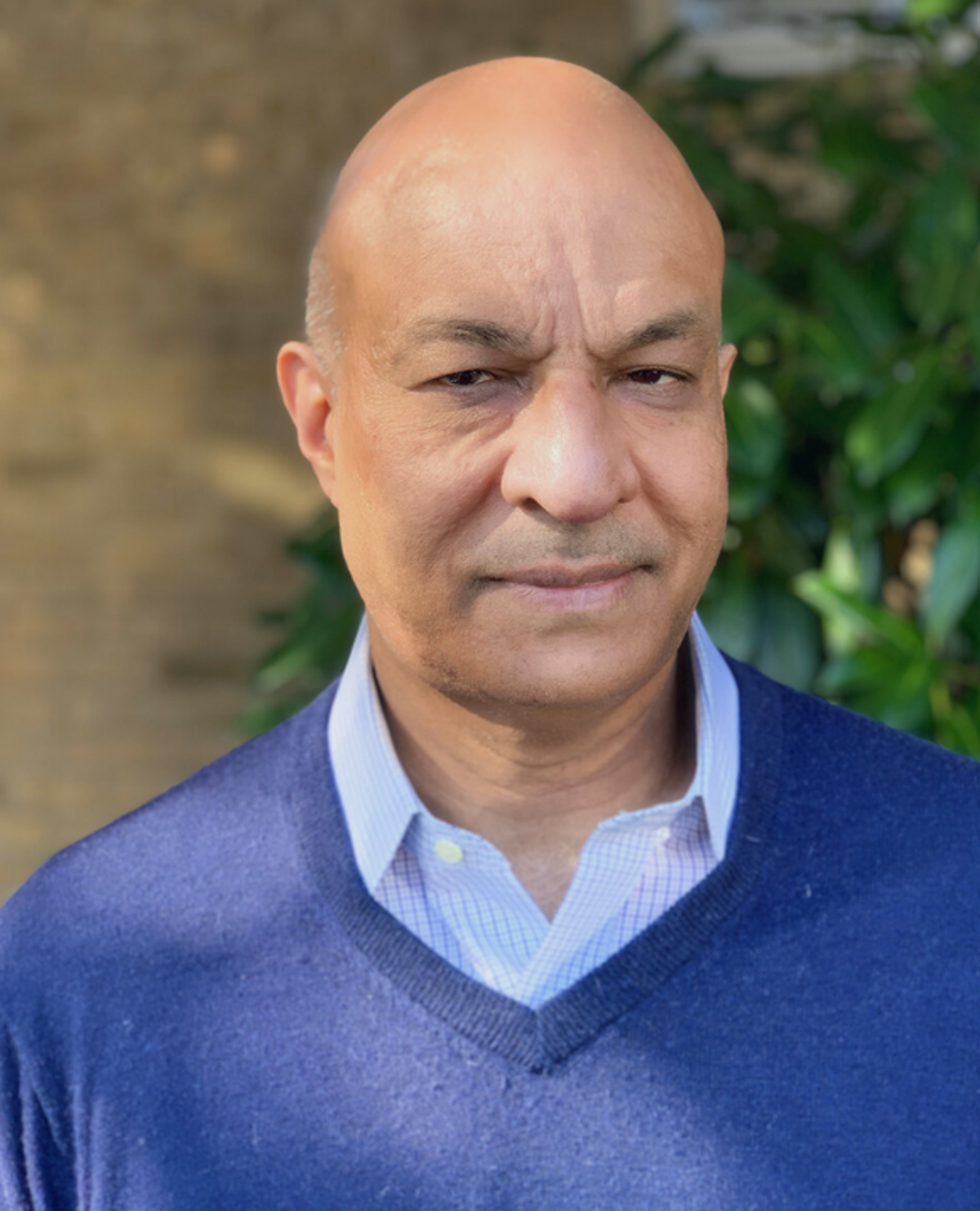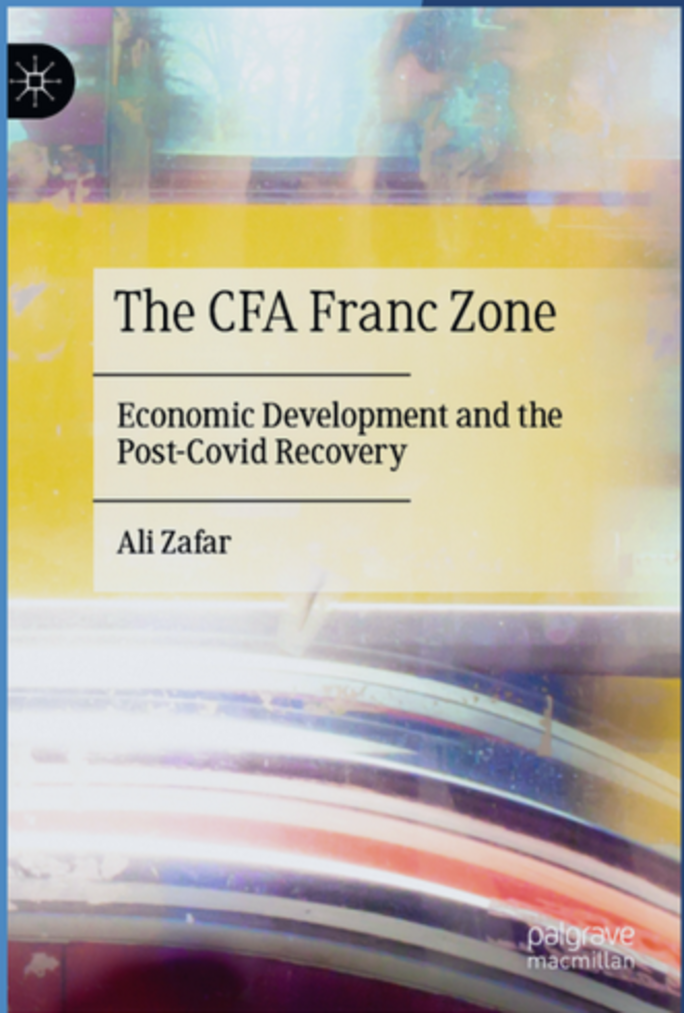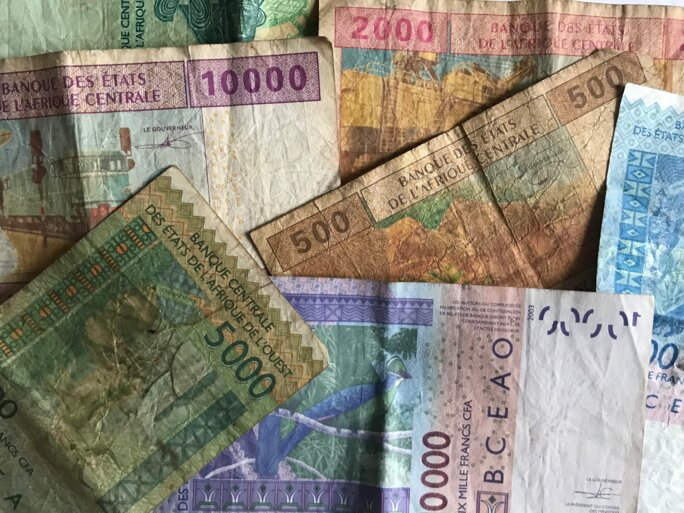♦ A quick introductory reminder: pegged to the euro, the CFA franc is a currency used by 14 countries in West and Central Africa, united in the West African Economic and Monetary Union (UEMOA/WAEMU, eight countries) and the Central African Economic and Monetary Community (CEMAC, six countries). Created in 1945, during the colonial period, the CFA franc is still governed by the same operating principles. Contrary to the announcements made by Emmanuel Macron in December 2019, the CFA franc of the WAEMU has not changed its name and remains under the close control of Paris, as the CFA franc of the CEMAC. ♦
What led you to work on the CFA franc?
Ali Zafarr: I have worked as a macroeconomist at the World Bank and other organizations including the United Nations and Gates Foundation for the last two decades and have advised multiple governments around the developing world on economic policy. My professional interests have been macroeconomic policy, competitiveness, and private sector development.
I worked at the World Bank on the regional integration strategy for CEMAC in the early 2000s and macroeconomic strategy for several West African countries in the 2010s, and during the course of that work, I became more and more intrigued by the CFA zone. It is at the nexus of so many development challenges and one of the last frontiers in the world of stubborn rural poverty.
Before working on the economy of the franc zone countries, did you know how the CFA franc works?
Ali Zafar: I was not aware of the precise mechanism of the CFA franc zone. I initially accepted the conventional wisdom that it was an area of macroeconomic stability.

Agrandissement : Illustration 1

Over time, I discovered to my surprise that the system was a legacy of colonial rule and had not evolved much over the years and that the countries were falling behind the rest of the developing world. I was lucky to have studied French in high school in Italy so that helped me learn things quickly.
What did you find particularly surprising or shocking about the CFA franc?
Ali Zafar: There are several things that shocked me so I had to write a book on it, The CFA Franc Zone, Economic Development and the Post-Covid Recovery (Palgrave Macmillan, 2021)! First, the CFA franc zone has persisted for so long with a rigid arrangement despite the changing world economy and changing trade with the rest of the world. It is an outdated system that restricts the macroeconomic policy options for member countries, especially fiscal and monetary policy.
Secondly, it is not a development friendly regime, with the excessive focus on low inflation rather than economic growth and development. Nothing seems to be produced in the CFA franc zone besides primary commodity and metals and oil, in comparison to countries like Rwanda and Ghana.
Third, the Francophone political elite is tightly connected to France – politically, culturally, and economically, and is generally a supporter of the peg to the euro. In most of the developing world, including among the former British colonies, there was a clear break with the former colonial power, and elites, from Korea to Vietnam to Kenya to India and Mexico, were imbued with a strong nationalism and desire to be independent.
Your work has led you to find that the CFA franc in the WAEMU and CEMAC are overvalued - but not at the same level. Can you elaborate on how you arrived at this finding? What does this overvaluation mean in practice for CFA countries?
Ali Zafar: The CEMAC is more than 30 percent misaligned in 2020 and WAEMU is more than 20 percent misaligned. The methodology used to come up with these numbers is based on a CGE model, developed by Devarajan, Lewis, and Robinson (DLR) in the 1990s in the context of the CFA devaluation. It looks at the way the exchange rate should adjust to a trade shock. For example, if CEMAC is exporting oil at $100 a barrel, and the oil price falls to $50 a barrel, the DLR will measure the difference between the actual exchange rate (since the CFA is pegged and does not change) and the so-called “equilibrium” exchange rate (where the CFA would move in a more normal regime).
In practice, an overvalued exchange rate means a subsidy for imports and a tax on exports. In the absence of a devaluation, the system does not allow countries to respond to trade shocks. If commodity prices fall for example, the country has to borrow more or cut investment as it cannot respond in the conventional way by letting the exchange rate slide and support exports and curtail imports. As a result, the currency is prone to overvaluation.
What is the impact of the CFA system on household living standards?
Ali Zafar: The CFA system generally leads to lower per capita growth than an exchange rate regime that is more flexible. It is no accident that the countries with the most poverty reduction in Africa – Ghana, Ethiopia, Rwanda, and Mauritius – are countries with more flexible and competitive currencies. A depreciated exchange rate shifts resources from non-tradables (services) to tradables (domestic products and exports).
If you divide the society into five separate quintiles based on income, ranking from top to bottom, the top 20 percent benefit the most, while the next 60 percent benefit least as they are prevented from linking to regional and global value chains. Imagine that in West Africa, half the rice consumed is imported at tremendous cost to these countries.
For those at the very bottom, who are subsistence farmers, who may be importing food or fuel, further empirical work is needed on the impact of a cheaper currency on the marginal producers. The microeconomic work on the 1994 devaluation, which I refer to in my book, confirmed the increase in growth and reduction in poverty.
You say that the CFA franc is a system for elites. Why do you say this? Which elites are involved?
Ali Zafar: It is an international anomaly for such poor economies to be pegged to such an expensive currency. The system creates two classes of people. An overvalued and strong currency benefits the urban elite in Francophone Africa, who import cheaper foreign goods. It penalizes rural producers and domestic manufacturers, whose exports are too costly compared to those of competing countries. There are fewer economic incentives to produce goods locally.
Large foreign companies dominate the market, in areas ranging from utilities to ports to infrastructure provision. Strong importing lobbies also benefit from this system.
The tight system of credit rationing, which is one of the byproducts of the rules of the CFA franc zone, means that it is especially difficult for small and medium-sized industry from obtaining finance. If you compare Kenya and South Africa with Senegal and Gabon in terms of access to credit, then you will see a consistent pattern where the former have much higher rates of financial intermediation.
Moreover, the rules on free capital transfer between the zones and France mean that some of the Francophone elite purchases assets in Europe or moves capital overseas. It is a world of networks par excellence with high barriers to entry in any sector. The tight link between the French Treasury and the central banks, BCEAO and BEAC, cements all these links in formal arrangements. The euro peg and reserve pooling minimize exchange rate risk for French and other foreign companies in the CFA zone.
Apart from the level of overvaluation of their respective CFA franc, are there any other differences between CEMAC and WAEMU?
Ali Zafar: The CEMAC countries are those that are oil-rich (except Central African Republic). They suffer from the resource curse, whereby their natural resource wealth has not translated into social and economic development. CEMAC has the political economy of rentier states and many governance challenges. WAEMU is more democratic and has more vibrant civil society and contested space.
A second difference between the two is that WAEMU has more cohesion in terms of members’ pooling reserves than CEMAC. However, given that the CFA franc zone requires a pooling of 50 percent of reserves to support the peg, maintaining the arrangement is becoming increasingly difficult in both zones. In CEMAC, the decline in oil production and revenue, coupled with poor governance in Republic of Congo, Chad, and Equatorial Guinea, means that it will be increasingly costly to maintain the peg. CEMAC is clearly on a more unsustainable path than WAEMU at the moment, but the crises in the Sahel also are making reserve management in WAEMU increasingly difficult.
What are the differences between the CFA countries and other countries, such as those in Asia, especially on the issue of "monetary stability"?
Ali Zafar: Asian countries prioritized growth and competitiveness. They tolerated higher inflation than the CFA countries but the payoffs were rapid. They focused on export-led development and building both agricultural self-sufficiency and industrial capacity. They imported capital goods and then moved up the export value chain. The central banks were more developmentally focused than BEAC and BCEAO. The export boom helped reserves and made macroeconomic management easier. The inflation problem in Asia was solved by releasing productive and supply constraints.
What can we learn from these non-CFA countries?
Ali Zafar: The lesson from successful Asian economies is threefold: keep the currency competitive, support the agricultural sector with favorable policies in the early stages of development, and support industrial development with “smart” industrial policy (economic zones, government supporting “winners”, public-private collaboration). The Chinese, Vietnamese, and Bangladeshi experience is all about these factors.
What do you think about the option of creating national currencies to get out of the CFA franc?
Ali Zafar: My preferred solution in the book is for WAEMU to move to a basket peg with the euro, the dollar, and the renmimbi that is more in accordance with their trade patterns. For CEMAC, I propose a peg to the euro, dollar, and price of oil. It is important that the CEMAC currency moves when oil moves. Also, I propose changing the unclear French guarantee with a clear swap line from the ECB.
Regarding the option of creating national currencies, my concern is that many of the new national currencies will not have credibility on the market and will need some kind of nominal anchor. The challenges for the Guinean franc or the Democratic Republic of Congo franc are well-known. But for some countries, like Senegal, exiting the zone and creating its own currency, could make economic sense, provided they had the right institutional setup and arranged swap lines. As a macroeconomist, I prefer arrangements that give both stability and flexibility.
Today, does the ECOWAS ECO project seem like a good option to you?
Ali Zafar: The ECOWAS ECO project is a long-term dream. It would be good to have a common economic space in West Africa and a common currency. However, there are three main obstacles. One is the level of leadership, operational readiness of the countries, and institutions to govern the zone. Two is the lack of strong political cohesion and trust between the Anglophone and Francophone bloc. Finally, mixing an oil economy like Nigeria with many UEMOA non-oil economies seems very challenging, especially in terms of defining the anchor currency. The shocks are asymmetric, and it would be risky for CFA countries to be subject to the volatility of the Nigeria naira.
My proposal is for CFA countries to move to a basket peg and then integrate with countries like Ghana, which faces the same shocks as Cote d’Ivoire.
But isn't that what France is saying right now? What is the difference between the French government's option and yours?
Ali Zafar: The difference between my perspective and the French Treasury is that the French Treasury insists on the peg to the euro in return for a guarantee. I find the peg to the euro outdated, and it impedes the competitiveness of the CFA countries. In such a context, I favor a basket peg for WAEMU based on the tripartite dollar-euro-renminbi. Moreover, I propose replacing the ambiguous guarantee with a more clear swap line from the ECB. As we are seeing in CEMAC, France will not be able to provide the guarantee to CEMAC given France's own fiscal challenges. Informal conversations have confirmed to me that some French officials are agreeing with me. The CEMAC problem has become a contingent liability for the French Treasury. But geopolitics is trumping macroeconomics, especially French concerns about Russian influence.
The CEMAC peg is clearly unsustainable in the medium-term, a point the IMF is beginning to realize. The problems of the Republic of Congo, Chad, and others become problems of solvency rather than liquidity. The countries do not have the funds to maintain the peg in the medium-term in terms of reserve adequacy. In CEMAC, the peg has to be to a basket linked to the euro, dollar, and price of oil. In WAEMU, Senegal and Cote d'Ivoire will not be able to support the system forever with their limited reserves. The exchange rate must delink from the euro, better sooner than later.
You studied the consequences of the COVID-19 pandemic on African countries. Had the pandemic a greater impact on franc zone countries than on other African countries, and why?
Ali Zafar: The CFA franc zone, partly because it is less integrated in global value chains and logistics and transport networks, had fewer deaths than most of the world.

However, the economic impact has been as strong as in other parts of the continent, except in South Africa, where the pandemic had a much greater impact. What is different in the CFA zone is the lack of fiscal and monetary policy tools (interest rates, money supply changes) that policymakers could use to respond to the pandemic.
You worked for a long time at the World Bank. Is it true that IMF and World Bank economists who have done work showing that the CFA franc is dysfunctional cannot publish it? Is it possible today to discuss the CFA franc within the international financial institutions, namely the IMF and the World Bank?
Ali Zafar: As can be seen by the lack of publications, there is generally a taboo at international financial institutions on writing on the CFA zone. It is not a career builder for staff working in these organizations. That is why the system is not challenged. Several of the economists I interviewed for the book asked that their names not be mentioned in the book. If an article is written, it is generally to praise the system for macroeconomic stability rather than criticize the system for poor development outcomes.
As I argue in my book, there has been a deficiency of courage on the CFA among intellectuals and a triumph of politics over economics. We must talk about it as it is important for the future of Francophone Africa. But the world is starting to change.
Is it true that in the discussions between the African countries of the franc zone and the IMF, the 'monetary part' is excluded according to a sort of gentlemen's agreement ?
Ali Zafar: I am not aware of this agreement, but I am aware that the IMF has been cautious on its pronouncements on the CFA franc zone and been quite inconsistent in its policy advice. There are many interesting IMF reports on Egypt and Nigeria, where the IMF supports the importance of exchange rate flexibility to adapt to shocks, but somehow, this is not applied to the CFA franc zone. Intellectuals can be captured by the prevailing orthodoxy without critically examining it.
Did the World Bank support you in the publication of your book?
Ali Zafar: The book was written and published when I was no longer at the World Bank. The World Bank focuses more on structural policy, while macro and exchange rate management are more the domain of the IMF.
It was a dream of mine to write this book for a long time as I felt that the CFA franc arrangement is a significant factor holding Francophone Africa back and preventing many of these countries from development success that was seen in many parts of the developing world.
My aim was to bring macroeconomic expertise and Asian experiences and to provide clear alternatives to the outdated CFA exchange rate regime. My hope is that Francophone African policymakers will think critically of moving beyond this system to deliver stronger growth for the populations. It is not a magic solution, but getting rid of the euro peg is an essential first step.
You took part in a symposium on the future of the CFA franc in May 2021 in Togo. What did you learn from it?
Ali Zafar: It was an exciting event, and I was happy to meet so many interesting colleagues who wanted to move beyond the current sterile debate and were happy to propose alternatives to the CFA. It surprised me that there was so little Anglophone participation. To an outsider, it feels that the Anglophone and Francophone worlds are separate universes, who need to communicate much better with each other. I was also concerned that it was only academics, not policymakers. I believe open and honest discussion is the way to move forward.
Interview conducted by Fanny Pigeaud
Version française à lire ici : https://blogs.mediapart.fr/fanny-pigeaud/blog/251121/le-franc-cfa-un-systeme-obsolete-qui-n-est-pas-favorable-au-developpement

Agrandissement : Illustration 3




